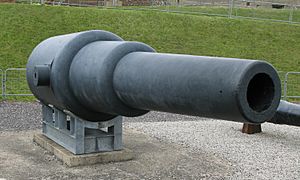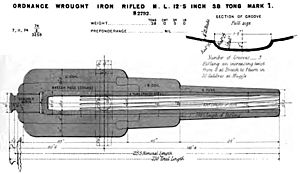RML 12.5-inch 38-ton gun facts for kids
Quick facts for kids Ordnance RML 12.5-inch 38-ton gun |
|
|---|---|

Gun at Fort Nelson, Portsmouth, UK
|
|
| Type | Naval gun Coast defence gun |
| Place of origin | United Kingdom |
| Service history | |
| In service | 1875–1905 |
| Used by | Royal Navy |
| Production history | |
| Designer | Royal Gun Factory |
| Designed | 1874 |
| Manufacturer | Royal Arsenal |
| Variants | Mk I, Mk II |
| Specifications | |
| Barrel length | 198 inches (5.0 m) (bore) |
|
|
|
| Shell | 800 to 809 pounds (362.9 to 367.0 kg) Palliser, Common, Shrapnel |
| Calibre | 12.5-inch (317.5 mm) |
| Muzzle velocity | Mk I : 1,425 feet per second (434 m/s) Mk II : 1,575 feet per second (480 m/s) |
| Maximum firing range | Mk I : 6,000 yards (5,500 m) Mk II : 6,500 yards (5,900 m) |
The RML 12.5-inch guns were huge cannons used by the British Navy and for protecting coastlines. These powerful guns were 'rifled muzzle-loaders,' meaning they had special grooves inside the barrel to make shells spin, and they were loaded from the front. They were some of the biggest guns of their time.
Contents
How the Gun Was Designed
Engineers wanted a bigger and better 12-inch gun. After testing in 1874, they found that a 12.5-inch gun worked best. This new gun could fire a massive 800-pound shell using 130 pounds of gunpowder! It was built using strong steel and iron parts, similar to older guns, and was approved in 1875.
The inside of the gun barrel had nine special grooves. These grooves made the shell spin as it left the gun. This spinning made the shell fly straighter and hit targets more accurately.
There were two main versions of the gun: Mark I and Mark II. The Mark II had a larger area for the gunpowder. This allowed it to fire shells even faster and a bit farther than the Mark I.
This gun was one of the last big muzzle-loading guns made by the British. After 1880, they started using 'breechloaders,' which were loaded from the back. The next big naval gun was the BL 12-inch Mk II gun.
Where the Guns Were Used
These powerful guns were put on some important British warships. They were mounted on HMS Dreadnought, which started service in 1879. They were also on HMS Agamemnon (1883) and HMS Ajax (1885). These were the last British battleships built with muzzle-loading guns.
Types of Ammunition
When these guns were first used, their shells had small "studs" on them. These studs fit into the grooves inside the gun barrel. This made the shell spin when fired.
Later, a new invention called "gas-checks" was added to the shells. These gas-checks helped seal the gas behind the shell. This made the guns last longer and improved how far and accurately the shells flew.
Even newer "automatic gas-checks" were developed. These allowed the gun to fire shells without studs. This meant a whole new range of ammunition could be used.
-
1. RML 12.5in Studded Shell, located at Hurst Castle, UK
By 1885, the gun no longer fired studded ammunition without gas-checks. Instead, there were two main types of ammunition. One type was older studded shells with attached gas-checks. The other was newer studless shells with automatic gas-checks. "Case shot" ammunition was different; it did not have studs or need gas-checks.
See also
- List of naval guns
Where You Can See Them Today
You can still see some of these impressive guns in different places:
- Two guns are at Hurst Castle, UK. They were originally at Cliff End Battery.
- One gun is at Fort Nelson, Portsmouth, UK. It also came from Cliff End Battery.
- One gun is outside Fort Albert, Isle of Wight.
- Another gun (No 22 from 1876) is outside Calbourne Mill, Isle of Wight. It was also originally at Cliff End Battery.
- An unpreserved gun is at Fort Delimara, Malta.
- A gun on a replica carriage is at Harding's Battery, Gibraltar.
- Two guns (numbers 87 and 95, dated 1878) are now in the ditch at Fort Cunningham, Bermuda.











